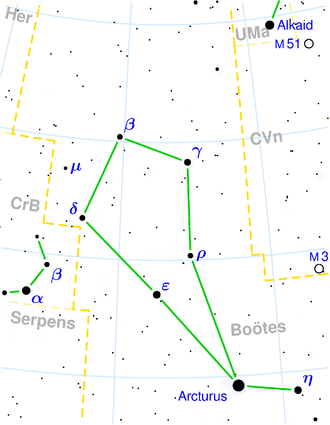NGC 5590
| Galaxy NGC 5580 / NGC 5590 |
|
|---|---|
![NGC 5580 with SDSS J142133.55 + 351107.2 [1] SDSS image](https://upload.wikimedia.org/wikipedia/commons/thumb/e/e8/NGC5590_-_SDSS_DR14.jpg/300px-NGC5590_-_SDSS_DR14.jpg)
|
|
| NGC 5580 with SDSS J142133.55 + 351107.2 SDSS Recording | |
| AladinLite | |
| Constellation | Bear keeper |
|
Position equinox : J2000.0 , epoch : J2000.0 |
|
| Right ascension | 14 h 21 m 38.4 s |
| declination | + 35 ° 12 ′ 18 ″ |
| Appearance | |
| Morphological type | S0 |
| Brightness (visual) | 12.3 mag |
| Brightness (B-band) | 13.3 mag |
| Angular expansion | 1.8 ′ × 1.8 ′ |
| Surface brightness | 13.5 mag / arcmin² |
| Physical data | |
| Affiliation | NGC 5557 group LGG 378 |
| Redshift | 0.010701 ± 0.000063 |
| Radial velocity | 3208 ± 19 km / s |
|
Stroke distance v rad / H 0 |
(147 ± 10) · 10 6 ly (45.0 ± 3.2) Mpc |
| history | |
| discovery | Wilhelm Herschel |
| Discovery date | May 1, 1785 |
| Catalog names | |
| NGC 5590 • 5580 • UGC 9200 • PGC 51312 • CGCG 192-006 • MCG + 06-32-006 • 2MASX J14213841 + 3512178 • GC 3860 • H III 417 • h 1791 • NSA 144931 • LDCE 1052 NED006 | |
NGC 5580 = NGC 5590 is a 12.3 mag bright lens-shaped galaxy of the Hubble-type S0 in the constellation Bear Guardian in the northern sky . It is estimated to be 147 million light years from the Milky Way and about 75,000 light years in diameter.
In the same area of the sky are u. a. the galaxies NGC 5567 , NGC 5568 , NGC 5579 , NGC 5588 .
The object was discovered together with NGC 5589 during an observation on May 1, 1785 by Wilhelm Herschel with an 18.7-inch reflector telescope, which they labeled “Two. Both vF, S, distance 6 ′ or 7 ′ “described ( NGC 5590 ). John Herschel watched her twice; on May 9, 1826, he confirmed his father's discovery; the observation on April 27, 1827 led to the second catalog entry under NGC 5580 with slightly different position data .
